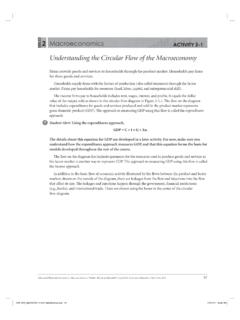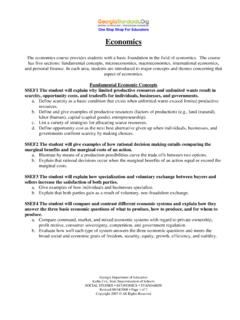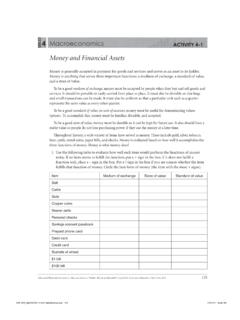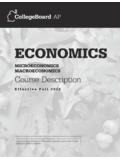Transcription of The Tools of Fiscal Policy - Ms. Brown's Economics …
1 advanced placement Economics macroeconomics : Student Resource Manual Council for economic Education, New York, 1675 MacroeconomicsThe Tools of Fiscal PolicyChanges in taxes and government spending designed to affect the level of aggregate demand in the economy are called Fiscal that aggregate demand is the total amount of spending on goods and services in the economy during a stated period of time and is made up of consumer spending (C), investment (I), government spending (G), and net exports (Xn). Aggregate supply is the total amount of goods and services available in the a recession, the short-run equilibrium is below the full-employment level of output.
2 Aggregate demand is too low to bring about full employment of resources. Government can increase aggregate demand by spending more and/or cutting taxes. Increasing aggregate demand to move the economy toward full employment is expansionary Fiscal Policy . Expansionary Fiscal Policy increases employment but also can raise the price level and result in budget the level of aggregate demand is too high, it creates inflationary pressures. Government can decrease aggregate demand by reducing spending and/or increasing taxes. Decreasing aggregate demand to decrease inflationary pressures is contractionary Fiscal Policy .
3 Contractionary Fiscal Policy reduces inflationary pressures but can also decrease output and employment. Contractionary Fiscal Policy can result in budget surpluses (or smaller budget deficits).Student Alert: Remember that the multiplier is different for taxes and for spending!Decide whether each of the following Fiscal policies of the federal government is expansionary or contractionary. Write expansionary or contractionary, and explain the reasons for your The government cuts business and personal income taxes and increases its own The government increases the personal income tax, Social Security tax, and corporate income tax.
4 Government spending stays the same. 3. Government spending goes up while taxes remain the The government reduces the wages of its employees while raising taxes on consumers and businesses. Other government spending remains the 16727/07/12 10:46 PM168 advanced placement Economics macroeconomics : Student Resource Manual Council for economic Education, New York, 5-1 (CONTINUED)Effects of Fiscal PolicyTest your understanding of Fiscal Policy by completing Table Your choices for each situation must be consistent that is, you should choose either an expansionary or contractionary Fiscal Policy .
5 ( Fiscal Policy cannot provide a solution to one of the situations.) Fill in the spaces as follows:Column A: Objective for aggregate demandDraw an up arrow to increase aggregate demand or a down arrow to decrease aggregate B: Action on taxesDraw an up arrow to increase taxes or a down arrow to decrease C: Action on government spendingDraw an up arrow to increase government spending or a down arrow to decrease government D: Effect on federal budgetWrite toward deficit if your action will increase the deficit (or reduce the surplus) or toward surplus if your action will reduce the deficit (or increase the surplus).
6 Column E: Effect on national bebtDraw an up arrow if your action will increase the national debt or a down arrow if your action will decrease the national of Fiscal Policy (A) Objective for aggregate demand(B) Action on taxes(C) Action on government spending(D) Effect on federal budget(E) Effect on national debt1. National unemployment rate rises to 12 Inflation is strong at a rate of 14 percent per Surverys show consumers are losing confidence in the economy, retail sales are weak, and business inventories are increasing Business sales and investment are expanding rapidly, and economists think strong inflation lies Inflation persists while unemployment stays 16827/07/12 10:46 PMAdvanced placement Economics macroeconomics .
7 Student Resource Manual Council for economic Education, New York, 1695 MacroeconomicsDiscretionary Fiscal Policy and Automatic StabilizersOne of the goals of economic Policy is to stabilize the economy. This means promoting full employment and stable prices. To accomplish this, aggregate demand must be near the full-employment level of output. If aggregate demand is too low, there will be unemployment. If aggregate demand is too high, there will be aggregate demand is too low, government can use Fiscal Policy to stimulate the economy through increased spending or decreased taxes. These policies are examples of expansionary Fiscal Policy .
8 If government wants to decrease aggregate demand, it can pursue a contractionary Fiscal Policy by decreasing taxes or increasing spending. If government has to pass a law or take some other specific action to change taxes or spending, then the action is at the government s discretion and the Policy is discretionary Policy . If the effect happens automatically as the economic situation changes, then the Policy is the result of an automatic stabilizer. An example of an automatic stabilizer is unemployment compensation. If the economy goes into a recession, some people are laid off and are eligible to receive unemployment compensation.
9 The payment creates income and spending to keep aggregate demand from falling as much as it would have. Unemployment compensation stabilizes the economy automatically during a each of the scenarios on the following page, indicate whether it represents an automatic (A) or discretionary (D) stabilizer, and whether it is an example of expansionary (E) or contractionary (C) Fiscal scenariosAutomatic (A) or Discretionary (D) Expansionary (E) or Contractionary (C)Example: Recession raises amount of unemployment The government cuts personal income tax rates. 2. The government eliminates favorable tax treatment on long-term capital gains.
10 3. Incomes rise; as a result, people pay a larger fraction of their income in taxes. 4. As a result of a recession, more families qualify for food stamps and welfare benefits. ACTIVITY 16927/07/12 10:46 PM170 advanced placement Economics macroeconomics : Student Resource Manual Council for economic Education, New York, scenariosAutomatic (A) or Discretionary (D) Expansionary (E) or Contractionary (C)5. The government eliminates the deductibility of interest expense for tax purposes. 6. The government launches a major new space program to explore Mars. 7. The government raises Social Security taxes.











